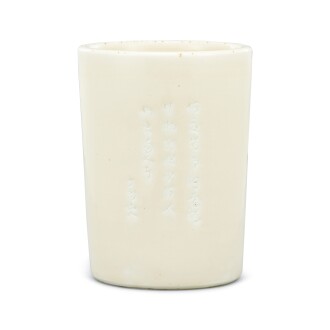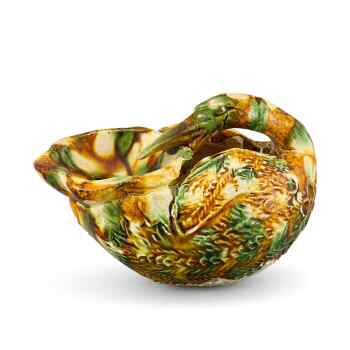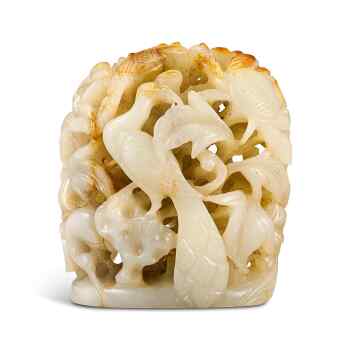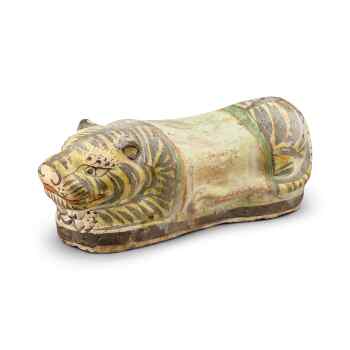T his season’s ‘CHINA / 5000 YEARS’ auction on 26th and 27th May showcases a diverse range of Chinese works of art including imperial porcelain, jade, lacquer, furniture and paintings. The sale also features a Hong Kong private collection of imperial porcelain and works of art, early ceramic pillows from the Dream Quest Collection, furniture and jade carvings from old Hong Kong family collections. Other highlights include a rare Jiajing wucai ‘fish’ jar from the collection of the renowned Japanese painter Umehara Ryuzaburo (1888-1986), an exquisite famille-rose ‘landscape’ snuff box and a cinnabar lacquer quatrelobed box and cover from the Qianlong period.

Eight works from the collection of Umehara Ryuzaburo (1888-1986) showcases this intrepid artist’s profound contribution to this period and offers a unique understanding of the evolution of art in East Asia. The Kyoto-born artist was one of the first pioneers in the Western Post-Impressionist style, and at the same time fascinated by China’s rich cultural history. During his sojourns in Beijing, he would paint many versions of the Forbidden Palace and Temple of Heaven. He would also frequent antique shops and became an avid collector of Chinese antiquities. Having practiced under Pierre-Auguste Renoir, Umehara was a natural colourist and his affinity to dynamic compositions and vivid hues is also reflected in the colourful wucai porcelain from his collection in this sale.

Estimate 1,000,000 - 1,500,000 HKD
Boldly painted with a whimsical scene of fish swimming amidst waterweeds, the present jar depicts one of the most iconic designs during the Jiajing period. It is an exceptional piece of imperial Chinese porcelain which embodied the Emperor's obsession with ancient Daoist values, as well as a joyful notion of a carefree life.
VIEW LOT

Estimate 180,000 - 250,000 HKD
This rare limestone rectangular stele, finely carved with sensuous naturalistic detail of each of the fours sides with a sculpture of a Buddha and bodhisattva, bears testimony to the development of Buddhist devotional art in China. It served as a vehicle for its fervent commissioner to accumulate merits and record their acts of devotion.
VIEW LOT

Invented in the Tang dynasty, ceramic pillows had became popular and treasured items for elite families by the Song dynasty. The hardness of the ceramic might seem uncomfortable to sleep on, but the cool touch of the material to the back of the neck would have been quite soothing on hot nights. The headrest may also bring some additional health benefits according to late-Ming scholar, Gao Lian, who wrote that the material and the iconography of the headrest serves a critical role in mediating between the conscious and unconscious, as dreams were believed to have significant meaning.
The Dream Quest Collection was assembled since 1990. Beginning with an interest in Cizhou ceramic pillows, the collector gradually expanded his collection to other provincial kilns. A comprehensive collection of over 100 ceramic pillows, spanning from the Tang to the Qing dynasties, of was amassed. The headrests could come in various shapes, techniques, glazes and decoration – typically rectangular or bean-shaped with a gently concave surface. Some examples come in the form of reclining figures. The pillow’s function associates it as an object of the bedroom, so the decoration would often have links to familial, domestic or even erotic themes.

In the scholar’s studio there is nothing more essential than the ink brush, as it is the key that will open up entire realms of calligraphy and landscape painting. Because of this unique relationship, the brush pot means more to a scholar than just a container to hold the many upturned brushes of various shapes, sizes, and styles. Made of variety of materials including bamboo, wood, lacquer, ivory, jade, glass and porcelain, the vessel is often decorated with evocative images of lonely figures in mountainous landscapes or bamboo groves. These scenes present ideas for contemplation, guiding explorations on the very connections between beauty and truth.

Snuff boxes and bottles are microcosms of Chinese works of art. The antique enamelling showcases the broad range of Qing dynasty works of art in miniature. The application of the enamel on porcelain, glass or other materials require technical virtuosity and skilled workmanship, and the styles offer a glimpse into the aesthetic preferences of different Qing emperors. For example, it is extremely rare to find foreign figures painted on porcelain and indeed foreigners were more frequently depicted on metal, especially during the reign of the Qianlong Emperor, when enamelling on metal had reached its peak. This reflected the emperor's extravagant taste for showy and unusual pieces. This rare snuff box represents a harmonious blend of Chinese and Western tastes. Qianlong was known for his penchant for pieces that were either technically innovative or unconventional in their design and aesthetics, and this box and cover would have been one of his 'curios' in his ceramic collection. The quality of the famille-rose enamelled decoration on this rare box and cover, skilfully mounted in gold alloy, matches that on famous Qianlong-marked European-subject decorated in the Palace Museum, Beijing and private collections.
An Extremely Rare Famille-Rose 'European subject' Box and Cover
Qing dynasty, Qianlong period


For thousands of years stretching back to the days of prehistoric cave paintings, our art has taken as subject matter flora and fauna of all kinds. The artist’s fascination with animals has expressed itself in stories and dreams — as deities and demons, fables and fantasies, loyal companions and wild enemies. Animals in Chinese art have long been a way of conveying philosophical and sometimes political meaning in a sophisticated visual language of cultural associations and wordplay. Depictions of animals cannot be construed as superficial or merely decorative. Real and mythical animals had spiritual meanings bound to individual motifs, and they were assigned specific places within in the universe in accord with Chinese cosmology.
- Duck
- Beast
- Horse
- Peacock
- Ox
- Tiger
-
 A sancai 'duck' form oil lamp
A sancai 'duck' form oil lamp -
 A longquan celadon ‘mythical beast’ footed bowl
A longquan celadon ‘mythical beast’ footed bowl -
 A blue and white 'Eight horses of Muwang' bowl
A blue and white 'Eight horses of Muwang' bowl -
 A pale celadon and russet jade 'peacock' censer finial Yuan - Ming Dynasty
A pale celadon and russet jade 'peacock' censer finial Yuan - Ming Dynasty -
 A sancai figure of an ox
A sancai figure of an ox -
 A Cizhou painted 'tiger' pillow Northern
A Cizhou painted 'tiger' pillow Northern

From bright scarlet and to deep burgundy, the colour of red lacquer is extremely versatile and can fill a room with energy. The auspicious colour gives off warmth, and thus has associations with vitality, youth, and fertility. Because of its striking nature, red in many other cultures is also identified as having intense qualities – i.e., passion, love and power.



















